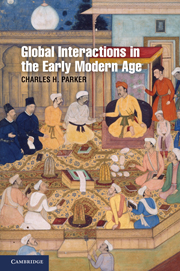Book contents
- Frontmatter
- Contents
- Maps
- Acknowledgments
- Global Interactions in the Early Modern Age, 1400–1800
- Introduction: The Global Integration of Space
- 1 European States and Overseas Empires
- 2 Asian States and Territorial Empires
- 3 International Markets and Global Exchange Networks
- 4 The Movement of Peoples and Diffusion of Cultures
- 5 The Formation of New Demographic and Ecological Structures
- 6 The Transmission of Religion and Culture
- Conclusion: Converging Destinies
- Notes
- Index
- References
3 - International Markets and Global Exchange Networks
Published online by Cambridge University Press: 05 June 2012
- Frontmatter
- Contents
- Maps
- Acknowledgments
- Global Interactions in the Early Modern Age, 1400–1800
- Introduction: The Global Integration of Space
- 1 European States and Overseas Empires
- 2 Asian States and Territorial Empires
- 3 International Markets and Global Exchange Networks
- 4 The Movement of Peoples and Diffusion of Cultures
- 5 The Formation of New Demographic and Ecological Structures
- 6 The Transmission of Religion and Culture
- Conclusion: Converging Destinies
- Notes
- Index
- References
Summary
The exchange of manufactured goods and cultivated foodstuffs has formed an integral part of human history in most every corner of the planet from the earliest days of our existence down to the present. Trading products has been such a profitable economic activity that countless merchants have been willing to travel long distances often on foot, astride a cranky animal, or inside a rickety sailing vessel to conduct business. Even in civilizations in the remote past – from 4,000 to 600 years ago – buyers and sellers trekked as far as from Mesopotamia (Iraq) to the Indus River Valley (Pakistan) in Asia, from southern Mexico to present day Vera Cruz in America, and from Mali to Morocco in Africa. As early as 2,000 to 3,000 years ago, long-distance traders moved along regularly traveled routes. The longest and the most renowned was the Silk Roads, a complex of routes that facilitated overland and maritime trade from the Mediterranean to the South China Sea. Despite all kinds of cataclysms, from falling empires in Persia, China, Guatemala, and Rome, to marauding Timurids in Asia, to ravaging plagues in Eurasia, merchant groups continued to ply their trade down to the early modern age of empire building.
Long distance commerce in this age of global engagement developed out of longstanding networks and all the financial mechanisms that made them work.
- Type
- Chapter
- Information
- Global Interactions in the Early Modern Age, 1400–1800 , pp. 68 - 109Publisher: Cambridge University PressPrint publication year: 2010



